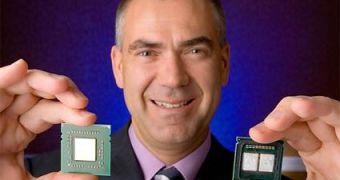Since Intel came out with their "world's first quad-core processor", people started believing that the chip giant had the upper hand on AMD, and their supremacy in the processor business is being proven once again by succeeding in having the quad-core processor first. But AMD had another opinion on the matter, their quad-core processor, codenamed Barcelona, is deemed to still have a chance for the title "world's first quad-core processor". Why? Because Intel's solution was done in haste, a rather strange aspect if you consider that they are still the number one players in this business, because they don't have a native quad-core processor.
The truth was soon clear; Intel had used a Multi-Chip Module (MCM) to link together two dual core processors on the same die, creating a surrogate quad-core processor. This in turn allowed them to bring the processors to market way ahead of AMD, and their only hope was that people would grow to like their offerings better, or at least make the best of the time they had alone on the market. The process in which Intel created their quad-core model is cheap and fast and managed to do the necessary work, but AMD still has the option of winning back some market share when they bring out their native quad-core processor, but some people tend to disagree.
Kirk Skaugen, the General Manager of Intel's Server Platforms Group stated that: "I can make lots of arguments for why more elegance and higher performance, but if I'm nine months late you blow that whole advantage away. I think Barcelona could be an intellectually elegant chip. Will the market care if its cost is higher and it can't ramp into volume at the frequency targets? Well, we'll have to see."
Kevin Knox, the Vice President of AMD's commercial business said that:"Originally, we had a big performance gap with Opteron. Woodcrest certainly narrowed that gap, but Barcelona will return us to a position where we have that big a gap again, if not bigger."
That being said, AMD sees the full side of the glass, while Intel is still seeing the empty side of things, but one major aspect to remember is that Intel is preparing their 45nm processors to have a 1600MHz FSB in order to be a good enough challenge for AMD's Barcelona, and a revamp of their product line in 2008 when they will introduce the Nehalem architecture. All in all, it seems we will have our hands full by then.

 14 DAY TRIAL //
14 DAY TRIAL //